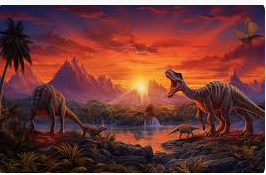The Fascinating World of Dinosaurs
Dinosaurs, the ancient rulers of the Earth, have fascinated scientists and enthusiasts for centuries. These incredible creatures roamed the planet for over 165 million years, evolving into a vast array of shapes, sizes, and lifestyles. From the towering Brachiosaurus to the fearsome Tyrannosaurus rex, their diversity was unmatched. But what do we truly know about them?
What Were Dinosaurs?
Dinosaurs are a group of reptiles that dominated the Mesozoic Era, often referred to as the “Age of Dinosaurs.” This era, spanning from approximately 250 to 65 million years ago, is divided into three periods:
- Triassic (250–201 million years ago): The dawn of dinosaurs. Early species like Eoraptor were small and agile.
- Jurassic (201–145 million years ago): A golden age for dinosaurs, marked by giants like Diplodocus and Allosaurus.
- Cretaceous (145–65 million years ago): The final chapter, featuring iconic species like Velociraptor and Triceratops.
Dinosaur Diversity
Dinosaurs were incredibly varied, with over 1,000 species identified to date. They can be classified into two main groups:
- Saurischians (“lizard-hipped”): Included theropods (like T. rex) and sauropodomorphs (like Brachiosaurus).
- Ornithischians (“bird-hipped”): Included herbivores like Stegosaurus and Ankylosaurus.
Some were massive, such as Argentinosaurus, which could weigh as much as 100 tons, while others, like Compsognathus, were no bigger than a chicken.
The Mystery of Their Extinction
Approximately 65 million years ago, a mass extinction event wiped out the non-avian dinosaurs. The most widely accepted theory is that a massive asteroid struck the Yucatán Peninsula, creating the Chicxulub crater. This impact caused catastrophic changes to the Earth’s climate, leading to the extinction of about 75% of all species.
Interestingly, not all dinosaurs vanished. Modern birds are now understood to be direct descendants of theropod dinosaurs, meaning the age of dinosaurs never truly ended.
Dinosaurs in Modern Culture
From blockbuster films like Jurassic Park to museum exhibits showcasing lifelike reconstructions, dinosaurs remain a vital part of popular culture. They continue to inspire curiosity about the natural world and the history of life on Earth.
What Dinosaurs Teach Us
Studying dinosaurs offers insights into evolution, extinction, and the resilience of life. It also reminds us of the fragility of ecosystems and the profound impact environmental changes can have on life.
Dinosaurs may have disappeared millions of years ago, but their legacy endures. They remain a symbol of nature’s power, adaptability, and beauty—a reminder of a time when giants ruled the Earth.




